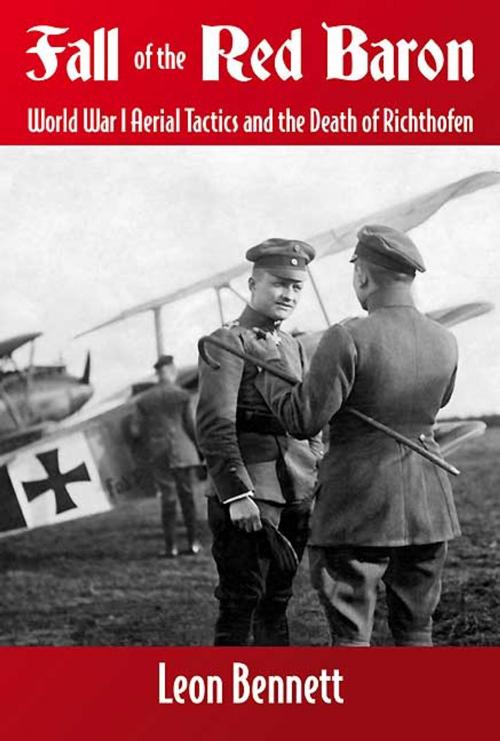Fall of the Red Baron: World War I Aerial Tactics and the Death of Richthofen
World War I Aerial Tactics and the Death of Richthofen
Nonfiction, History, Military, Aviation, World War I, Biography & Memoir, Historical| Author: | Bennett, Leon | ISBN: | 9781908916433 |
| Publisher: | Helion | Publication: | February 19, 2012 |
| Imprint: | Helion and Company | Language: | English |
| Author: | Bennett, Leon |
| ISBN: | 9781908916433 |
| Publisher: | Helion |
| Publication: | February 19, 2012 |
| Imprint: | Helion and Company |
| Language: | English |
Fighter pilot Manfred von Richthofen (the Red Baron) lacked innate aerobatic ability. As a tyro, he attempted to solve this problem through denial, going so far as to sneer at stunting as pointless. Great War air combat experience proved quite the reverse, and so we would anticipate a short and sad fighting life for the fellow. Yet the Red Baron became the Great War's single greatest scorer, as measured by total victories. How did he do it? This book is concerned with tactics, especially those tactics used by the Red Baron and his opponents. It offers the how and why of Great War aerial combat. The author leans heavily on his expertise in engineering and aerodynamic techniques to explain this, with his reasoning presented in a readable, non-mathematical style. Absent are both the usual propaganda-laced Air Service reports and psychobabble. Offered instead is the logic behind Great War aerial combat; i.e., those elements determining success or failure in the Red Baron's air war. Gunnery experience led to the machine gun as the weapon best suited for aerial combat. Joined with a suitable aircraft, the extremely successful Fokker diving attack resulted. In reaction, effective defensive techniques arose, using forms of shrewd tactical cooperation by two-seater crews: pilot and gunner. These are detailed. Numbers mattered, establishing the level of assault firepower. Tactics of machines flying together in formation are given, as well as those of 'formation busters', intent upon reversing the odds and turning large numbers into a disadvantage. A pilot's nature and emotions had much to do with choosing between the options defining tactics. What were the aces like? How were tactics tailored to suit personality? What traits made for the ability to grapple with a jammed machine gun? A dozen high achievers are examined in terms of tactics and background. In a fascinating study Leon Bennett covers all of these aspects of WWI aerial combat, and more. Similarly, the author turns his attention to examining the cause of von Richthofen's death, employing the tools of logic, rather than merely accepting one of the many conflicting eyewitness reports as truth. In doing so, much testimony is exposed as unlikely. The bullet scatter to be expected from ground anti-aircraft fire matters greatly, and is developed, along with the odds against lone riflemen hoping to hit a fast-moving low altitude target. The most dangerous altitude for front-line crossing is established. The author concludes by rating the possibility of a rifleman downing the Red Baron as quite realistic - certainly as likely as any of the more celebrated possibilities. This is an important book, offering a groundbreaking account of WWI aerial tactics, and a thorough examination of the final combat and death of the Red Baron.
Fighter pilot Manfred von Richthofen (the Red Baron) lacked innate aerobatic ability. As a tyro, he attempted to solve this problem through denial, going so far as to sneer at stunting as pointless. Great War air combat experience proved quite the reverse, and so we would anticipate a short and sad fighting life for the fellow. Yet the Red Baron became the Great War's single greatest scorer, as measured by total victories. How did he do it? This book is concerned with tactics, especially those tactics used by the Red Baron and his opponents. It offers the how and why of Great War aerial combat. The author leans heavily on his expertise in engineering and aerodynamic techniques to explain this, with his reasoning presented in a readable, non-mathematical style. Absent are both the usual propaganda-laced Air Service reports and psychobabble. Offered instead is the logic behind Great War aerial combat; i.e., those elements determining success or failure in the Red Baron's air war. Gunnery experience led to the machine gun as the weapon best suited for aerial combat. Joined with a suitable aircraft, the extremely successful Fokker diving attack resulted. In reaction, effective defensive techniques arose, using forms of shrewd tactical cooperation by two-seater crews: pilot and gunner. These are detailed. Numbers mattered, establishing the level of assault firepower. Tactics of machines flying together in formation are given, as well as those of 'formation busters', intent upon reversing the odds and turning large numbers into a disadvantage. A pilot's nature and emotions had much to do with choosing between the options defining tactics. What were the aces like? How were tactics tailored to suit personality? What traits made for the ability to grapple with a jammed machine gun? A dozen high achievers are examined in terms of tactics and background. In a fascinating study Leon Bennett covers all of these aspects of WWI aerial combat, and more. Similarly, the author turns his attention to examining the cause of von Richthofen's death, employing the tools of logic, rather than merely accepting one of the many conflicting eyewitness reports as truth. In doing so, much testimony is exposed as unlikely. The bullet scatter to be expected from ground anti-aircraft fire matters greatly, and is developed, along with the odds against lone riflemen hoping to hit a fast-moving low altitude target. The most dangerous altitude for front-line crossing is established. The author concludes by rating the possibility of a rifleman downing the Red Baron as quite realistic - certainly as likely as any of the more celebrated possibilities. This is an important book, offering a groundbreaking account of WWI aerial tactics, and a thorough examination of the final combat and death of the Red Baron.















